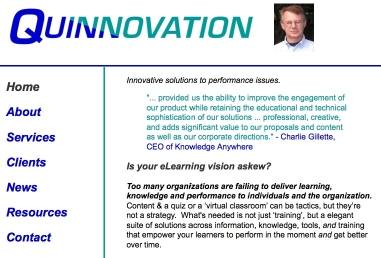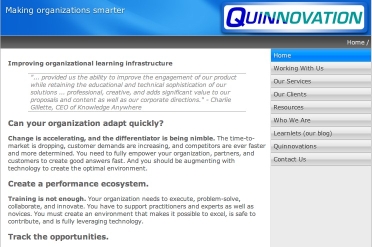I’m on the Board of Directors for an educational not-for-profit that has had almost 30 years of successful work with programs in classrooms, nationally and internationally. However, 5 years ago or so when I joined, they were doing almost nothing with technology. Since then I’ve been working systematically to get them to the stage where they’re leveraging technology not just for education, but for the organization.
 It’s been a slow road. There were several false starts along the way, with two separate groups within the organization having a go, but each withered. I wrote a vision document, laying out the opportunities, but they just weren’t getting the message; they were already successful. Several things have helped: the economic uncertainties of funding for the past few years, an external group that looked to partner for online delivery (which went awry, sadly), and the growing use of technology by their ever-younger employees (and their audience!).
It’s been a slow road. There were several false starts along the way, with two separate groups within the organization having a go, but each withered. I wrote a vision document, laying out the opportunities, but they just weren’t getting the message; they were already successful. Several things have helped: the economic uncertainties of funding for the past few years, an external group that looked to partner for online delivery (which went awry, sadly), and the growing use of technology by their ever-younger employees (and their audience!).
Mainly through persistence, consistently better messaging, and a growing awareness on the part of both Board and organization, I finally managed to get the Board to push for an IT Strategy from the organization, which led to the formation of an IT Committee on the Board. (For my sins I got to chair it.) Since then I’ve been working with the organization to start developing a strategy, though I can only advise.
Jumpstarting may seem hardly the right phrase for a several-years long process, but actually it’s a significant shift and real progress. They’re still having trouble getting a real strategic vision, focusing a bit too much on tactics like a killer website instead of back-end system and information architecture, but it’s within grasp now. I likely will be going down and giving the organization’s team a more in-depth view, and the Board has asked to get an overview of the new technologies and the opportunities. I’m even going to run a survey to see if we can move to more use of technology for the Board’s communications (the number of trees…).
Persistence pays off, even in the most hidebound environments. Serendipity helps, but you get better at getting the message across. And the number of examples now available makes it even easier. Jumper cables, anyone?


